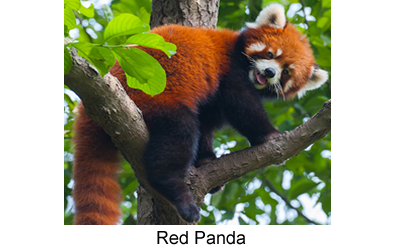 |
|
Name:
Red Panda Classification:
Class: Mammalia
Order: Carnivora
Family: Ailuridae
Genus: Ailurus
Species:Himalayan
Red Panda, A. fulgens fulgens; Size: Head-to-body
20-26 inches long, tail 12-20 inches long. Characteristics:
Quadruped, body and tail covered in fur. Small snout and ears. Long
fluffy tail. Paws have a pseudo-thumb for grabbing. Status: Endangered There are many cute fluffy animals in the world, but few can claim to be as cute as the red panda! Though they are called "pandas", red pandas aren't related to bears at all. They're the only living creature of the family Ailuridae and are more closely related to weasels and raccoons. They are found in the rainy forests and mountains of Bhutan, northern India, south-central China, northern Myanmar and Nepal. For many years it was thought that there were two subspecies of red panda, the Himalayan red panda (Ailurus fulgens fulgens) and the Chinese red panda, also called Styan's red panda (Ailurus fulgens styani). However, recent research conducted in early 2020 has strongly suggested that these two subspecies are in fact two separate species altogether! The Chinese red panda tends to be a bit larger and darker in color than the Himalayan red panda. Though they look similar, their DNA is actually quite distinct. Currently they do not have formal species names, so their old subspecies names will continue to be used until scientists have a chance to better classify them. Red pandas are active during the night, as well as the dawn and dusk hours. In captivity, however, a red panda may be active day or night. Red pandas spend most of their lives in the branches of trees. Red pandas are technically carnivores, yet they almost exclusively eat plants! Their favorite food is bamboo, but they also love to snack on acorns, eggs, roots and fruits. Sometimes they eat birds or small mammals. Red pandas have a pseudo-thumb on their paws, which they use to grab branches and their food. When it gets cold, they wrap themselves in a fluffy tail like a blanket! Red pandas are also capable of slowing their metabolism and sleeping for long periods, waking up every few hours to find food. This lets them conserve energy when they have the need. Red pandas live alone, except when seeking a mate. In the wild, red pandas usually live in territories about one square mile in size. They mark their territory with urine and special glands in their paws. After mating, females will make a nest in a tree hole, a hollow stump, tree roots, or bamboo thickets. They line these nests with soft materials like moss and leaves. A mother will carry her babies from 93-154 days and give birth during the spring and summer months. Usually 1-4 babies make a litter. A baby red panda will stay in its mother for about 90 days before it goes on its own. Red pandas are endangered. Their biggest threat is deforestation due human population growth. Road and community development, agriculture and mining are just a few reasons why the red panda's habitat is dwindling. Livestock herding and poaching are also serious problems. Some have estimated that around 10,000 red pandas are left in the world, and there could be as few as 2,500 in the wild. Though the situation is serious, much is being done to protect Asia's cutest critter. The Red Panda Network actively conducts research, conservation, and education by teaming up with local communities. The World Wildlife Fund also has been working with farmers in Nepal to advocate for the red panda. With a little luck and a lot of support, red pandas will be prowling the trees for many years to come. To learn more about these adorable "pandas" and how you can help save them, check out these awesome organizations: Red Panda Network-A
leader in the fight to save red pandas! World Wildlife Fund.
Red Panda Page-Check out what WWF is doing for the red pandas! |
|
|
|
|
||
|
Contact
Us
|
||||
|
Taproot
Guru © ALL RIGHTS RESERVED
|
||||